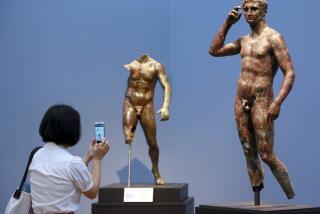KOUROS TO GO ON VIEW AT GETTY
- Share via
Following three years of intense scholarly scrutiny and meticulous conservation, a rare and controversial ancient Greek marble sculpture--said to be one of the most important art acquisitions in America in the last 50 years--goes on public view Tuesday at the J. Paul Getty Museum in Malibu.
The 6-foot-7-inch male nude figure, called a Kouros (young man), is of a type made in Greece from the 7th through the 5th centuries BC during the Archaic epoch. Dated by experts at about 530 BC, the 1,100-pound marble sculpture is one of only 13 well-preserved Kouros figures in existence. Museums around the world display more than 200 fragmentary works of a similar kind.
Placed on loan to the Getty in 1983, the statue was purchased in 1985 at an undisclosed price. The museum revealed the purchase in August to head off an emerging controversy about the figure’s authenticity. Italian conservation expert Pico Cellini has voiced doubts about stylistic anomalies in the Getty Kouros, but a majority of other authorities have resoundingly declared confidence in the work.
One of the most remarkable aspects of the piece is its state of preservation. Arms, lower legs and feet had been broken off the sculpture hundreds of years ago, but only a few fragments were lost. The monumental young man now stands upright without visible means of support, benefiting from an innovative system devised by Jerry Podany, the museum’s conservator of antiquities, and his staff.
Instead of drilling large holes in the statue and inserting steel rods to join severed parts, Podany attached them with a flexible -inch stainless steel cable. If the statue is subjected to an earthquake, its limbs are expected to open and close. As another precaution against seismic stress, the base of the sculpture is mounted on ball bearings attached to a centering device. The Getty Kouros is the central attraction of a gallery devoted to ancient Greek art, also opening Tuesday. The new display features art from the early Bronze Age through the early classical period, including the museum’s most significant recent acquisitions in stone, bronze, ceramic and carved gems.
Among other new arrivals at the Getty are a 5th-Century BC Greek bronze portraying a dying youth, a Cycladic marble figure of a harpist, circa 2300 BC and ceremonial horse trappings from the 6th Century BC. These rare objects are displayed alongside long-term members of the Getty’s collection of antiquities.
The museum is open Tuesdays through Sundays, 10 a.m. to 5 p.m. Admission is free but parking reservations are required: (213) 458-2003.
More to Read
The biggest entertainment stories
Get our big stories about Hollywood, film, television, music, arts, culture and more right in your inbox as soon as they publish.
You may occasionally receive promotional content from the Los Angeles Times.










